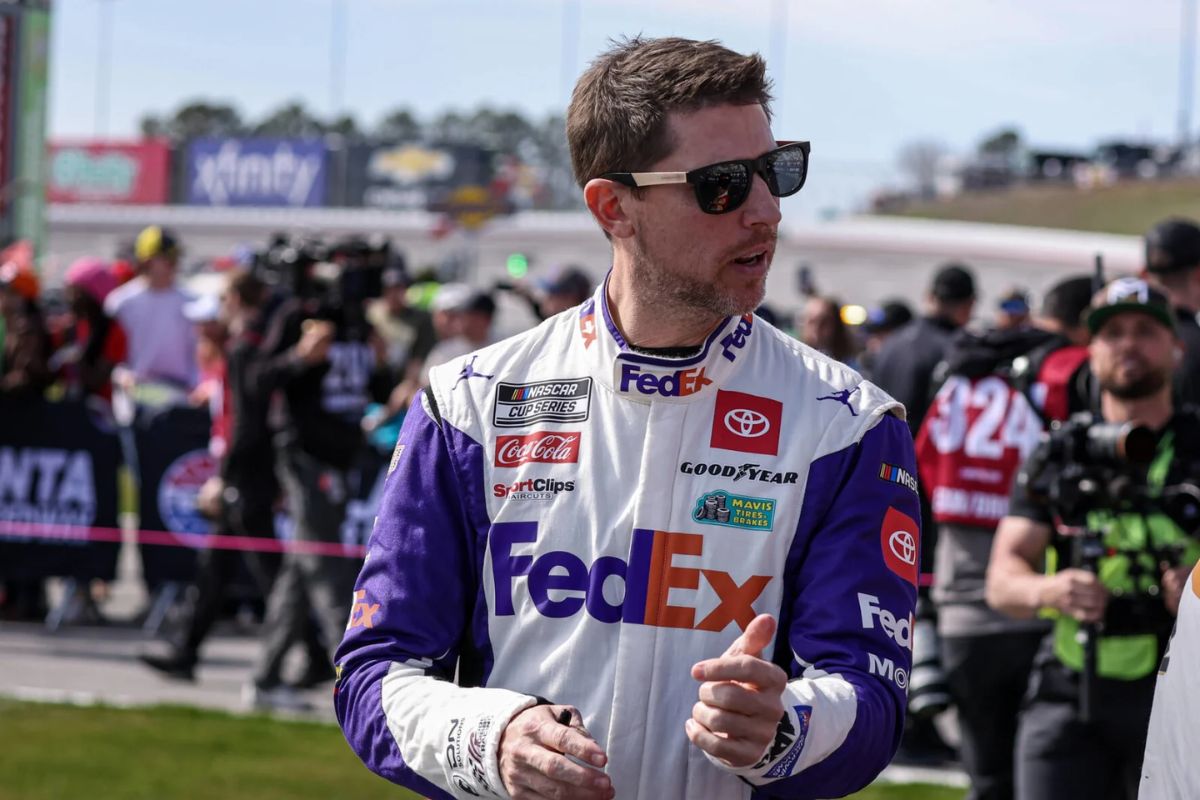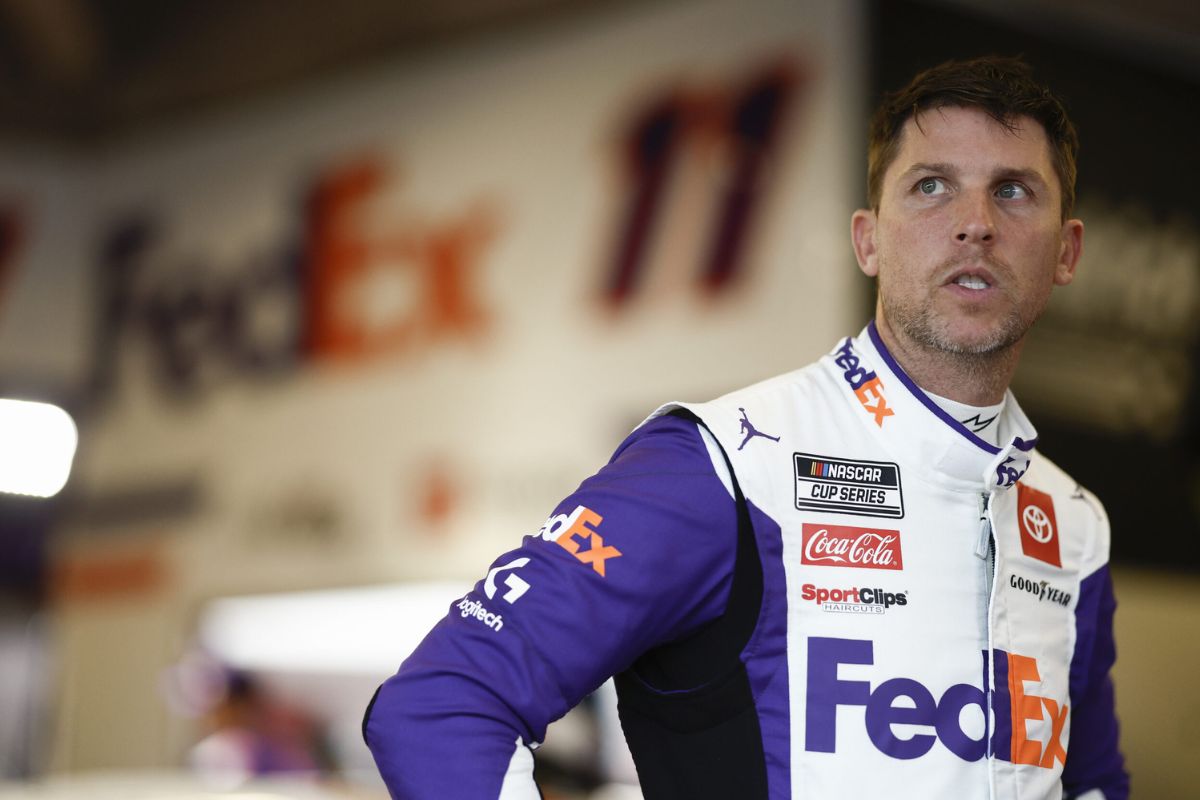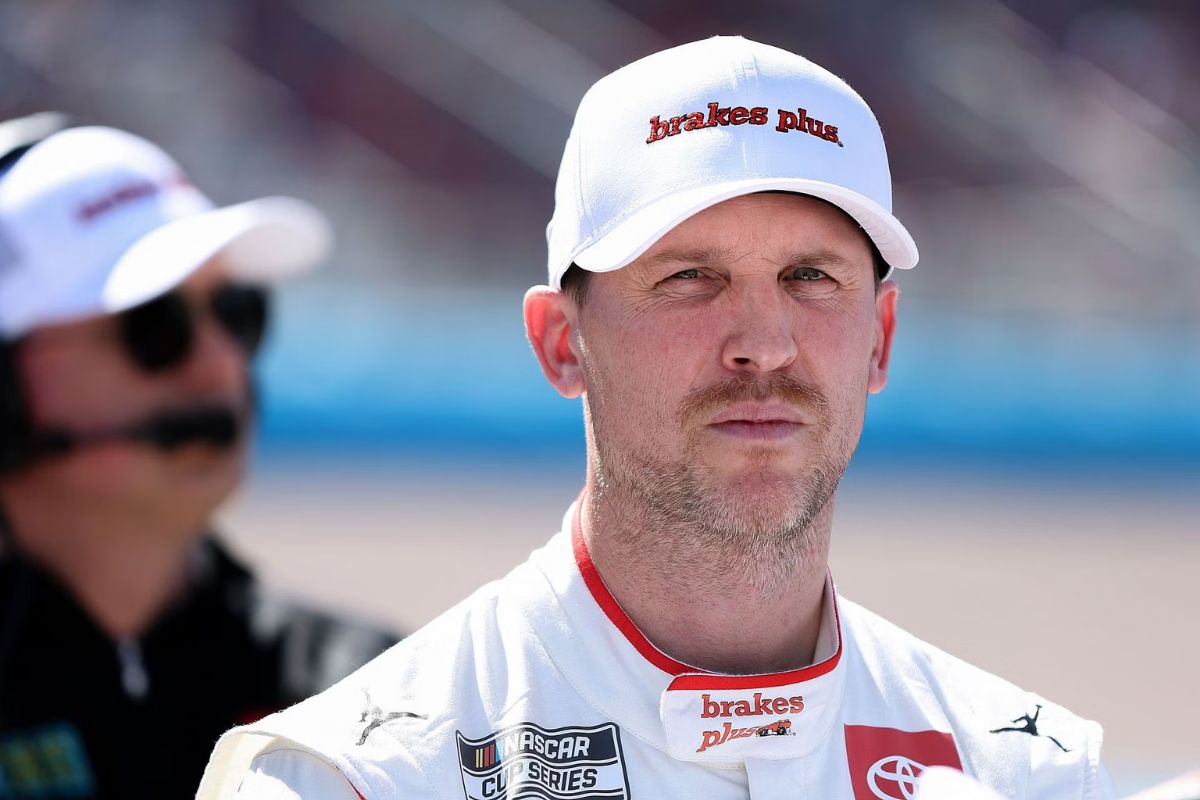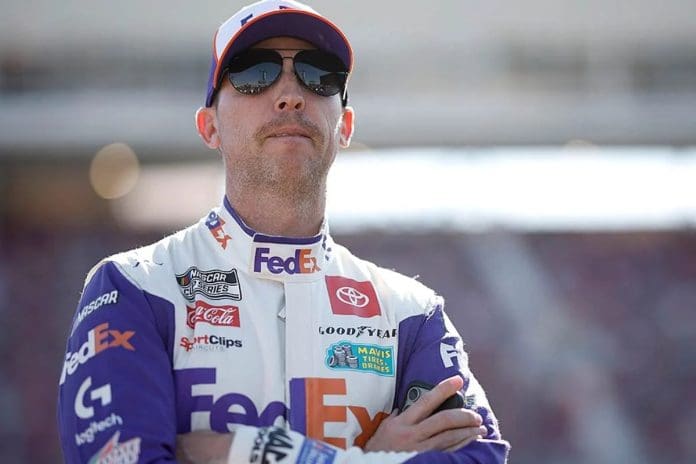Denny Hamlin’s Surprising Confession: In NASCAR, tracks play a pivotal role in shaping the racing experience for drivers and fans alike. Among these tracks, Kansas Speedway has emerged as a shining beacon, showcasing the thrilling capabilities of Next Gen cars like never before. Recently, Denny Hamlin shared his insightful analysis of Kansas Speedway on his podcast, shedding light on why this track is perfect for Next Gen cars and providing a critical analysis of NASCAR’s challenges. Let’s go deeper into Hamlin’s perspective and explore the dynamics of Kansas Speedway, along with the broader issues facing NASCAR.
KEY TAKEAWAYS
- Hamlin’s analysis highlights Kansas Speedway’s perfect fit for Next Gen cars, promising thrilling races and captivating finishes.
- Hamlin’s concerns underscore the necessity for NASCAR to enhance its media infrastructure, including faster processing and higher resolution cameras, to elevate the fan experience.
- The conversation stresses the importance of a clear start-finish line for accurate race outcomes, signaling the need for precise track markings.
- Hamlin and Allen’s discussion prompts a reevaluation of tracks like the ROVAL, urging NASCAR to prioritize venues that suit Next Gen cars.
- Advocacy for increased investment in track facilities aims to improve racing experiences and ensure a diverse schedule for NASCAR enthusiasts online.
DENNY HAMLIN’S ANALYSIS OF KANSAS TRACK
Kansas Speedway has emerged as a strong NASCAR circuit, showcasing the thrilling capabilities of Next Gen cars like never before. With its unique characteristics and layout, this racetrack has become the ideal stage for heart-pounding action and photo finishes, captivating fans and drivers alike. Denny Hamlin on his podcast poured his views on Kansas Speedway and how the track is perfect for NEXT-GEN cars and provides a critical analysis.
“This track just sets up perfectly for the car. I mentioned it after the race that um the the combination of it all it’s it’s we have lower horsepower. So we have to run at the top for momentum but there are opportunities at this track for you to run lower cut distance off slide up in front of somebody and then you know you’re not going to have a good run off the corner and then they’re going to repass you back down the straightway. So it’s just if you were designing a mile and a half nowadays it would be like give me whatever Kansas has got now you’d have to match the surface with it.”- Denny Hamlin
One of the defining features of Kansas Speedway is its draggy surface, a quality that allows for those electrifying photo finishes that leave spectators on the edge of their seats. When cars go side by side, the drag created by the air dumping onto the spoiler of the adjacent car slows them down, setting the stage for intense battles and last-second maneuvers.
Furthermore, the tire fall-off at Kansas adds another layer of complexity to the racing experience. Unlike other tracks where tire wear may not be as significant, at Kansas, drivers must contend with varying levels of grip as the race progresses.
The combination of lower horsepower and the need for momentum at Kansas creates a unique challenge for drivers. With opportunities to cut distance and make daring moves, the track rewards boldness and precision. Drivers must balance running at the top for momentum with the chance to dive low and steal positions, making for dynamic and unpredictable racing throughout.

THE NEED TO CHANGE REAR VIEW CAMERAS
In a recent conversation, Denny Hamlin raises concerns about the speed and quality of race footage delivery in NASCAR. While acknowledging the strides made by NASCAR in various aspects, there’s a growing sentiment that improvements are needed, particularly regarding the speed and resolution of photo delivery.
“We need that photo faster I think it took too long to get it out how long did that take it felt like an inter I don’t know yeah more than like I think you need to have like a minute or two. It felt like it was longer yeah you just need a higher resolution image camera look I don’t know what it is but I know that if I hate to I hate to complain about NASCAR because they just did uh did wonders to get my 560 vest back but if they send us footage of races, it’s in 720 which is like not very high quality.” – (denny hamlin)
There’s a visible frustration regarding the time it takes to obtain race photos. Some fans feel that the process takes longer than it should, impacting their overall experience. A higher resolution camera with faster processing capabilities could address this issue, providing fans with the high-quality images they crave in a more timely manner.
Additionally, concerns were voiced about the quality of footage provided by NASCAR, with some feeling that 720p resolution is insufficient. A higher resolution, perhaps even with a higher frame rate, would enhance the viewing experience and ensure that fans can fully appreciate the intensity and excitement of each race.

In an ideal scenario, attention to detail, such as ensuring straight and clear start-finish lines, would also contribute to the overall professionalism and integrity of NASCAR events. Crooked lines or inconsistencies may seem minor, but they can detract from the overall experience for both fans and participants.
THE START- FINISH DILEMMA
In a recent exchange, NASCAR driver Denny Hamlin and Travis shared thoughts on the state of the start-finish line at races, sparking a conversation about its clarity and precision. Despite the restart line appearing straight, concerns linger about potential imperfections in the painted line.
Denny Hamlin expressed surprise at the lack of a clear official end point on the track, expecting it to be visibly marked amidst the array of painted lines. However, the official line remains invisible, requiring thorough attention to detail during races for accurate photo finishes.
Denny: “And there’s got to be, Travis, probably 20 coats of paint on there. So, they would have a tough time. So what they could do is, since there’s a part of the white paint that’s thicker than the other, is you just paint a black stripe. You straight edge it and then black paint it so there is a straight line defined. And this goes back to the same technique as paving. You’ve got to erase it all and go back down to the start, right? You can’t just paint over the start-finish line every time.”
Travis highlighted the significant difference in height between the apron and the track surface, emphasizing the need for a hard, straight line to ensure consistency. Suggestions were made to employ a black stripe technique to define a clear, straight line, mitigating the challenges posed by multiple layers of paint.
“Even at the end, it’s… I mean, Travis, the restart line is straight. The paint doesn’t move, Travis. But you could put rubber on it. It’s not… there could be spots missing. Did you honestly think that the start-finish line was the official end?”-Travis
While acknowledging the difficulty in maintaining straight lines amidst layers of paint, both drivers stressed the importance of precision and clarity in defining the start-finish line. Any inconsistencies could potentially impact race outcomes and photo finishes, highlighting the need for attention to detail in track maintenance.
While challenges persist in maintaining straight lines amidst layers of paint, NASCAR must prioritize precision and clarity in defining the start-finish line. Implementing techniques such as black striping could offer a viable solution, ensuring consistency and accuracy in race outcomes.
Removing the ROVAL
In a candid conversation between NASCAR drivers Denny Hamlin and Jared Allen, the topic of track suitability for Next Gen cars took center stage, sparking a debate about the future of certain venues in the racing calendar. The focus shifted towards the Roval at Charlotte Motor Speedway, with both drivers questioning its compatibility with the capabilities of the Next Gen cars.
Denny Hamlin voiced concerns about the Roval’s unconventional layout, suggesting that the car’s strengths are better suited to traditional mile-and-a-half tracks rather than navigating through a makeshift course in a parking lot. Jared Allen reflected these sentiments, emphasizing the need for tracks that offer high-speed racing and play to the strengths of the Next Gen cars.
“I guess to uh, you know, as you’ve mentioned before that politics would play into this because if you take a like if you take the Roval out then you have to stick to an SMI track and neither Chicago-land or Kentucky are. Yeah, I mean maybe they could put some money back in Kentucky in the uh, you know, upgrade the infield there or something or you know get the elevators working.” – Jared Allen
The discussion then turned towards tracks like Chicagoland Speedway, with both drivers advocating for a reevaluation of the racing calendar to prioritize venues that align more closely with the Next Gen car’s capabilities. While acknowledging the importance of track facilities, both Hamlin and Allen stressed the need for thoughtful deliberation when considering changes to the schedule.

However, the conversation also delved into the political and financial implications of removing certain tracks from the schedule. Both drivers acknowledged the complexities involved, noting that any decision to remove the Roval would require NASCAR to stick to an SMI track, limiting options for alternative venues.
News in Brief : Denny Hamlin’s Surprising Confession
After the Kansas Race, Denny Hamlin brings a new perspective when talking about improving the camera quality and about painting the line. As we saw at Kansas , the race outcome depended on a very tiny margin, therefore, these two factors come into play and make a very big impact on choosing the winner.
Denny Hamlin’s insights into Kansas Speedway’s compatibility with Next Gen cars and the broader discussions on media infrastructure, track markings, and racing calendar decisions highlight the evolving landscape of NASCAR. As the sport continues to innovate and adapt, addressing these challenges will be crucial in delivering an enhanced and immersive experience for fans online.
Through strategic investments and thoughtful planning, NASCAR can ensure that tracks like Kansas Speedway remain at the forefront of exhilarating racing action in the digital age.
ALSO READ: Denny Hamlin Criticizes NASCAR Over Photo Finish Error


